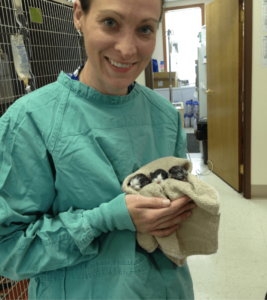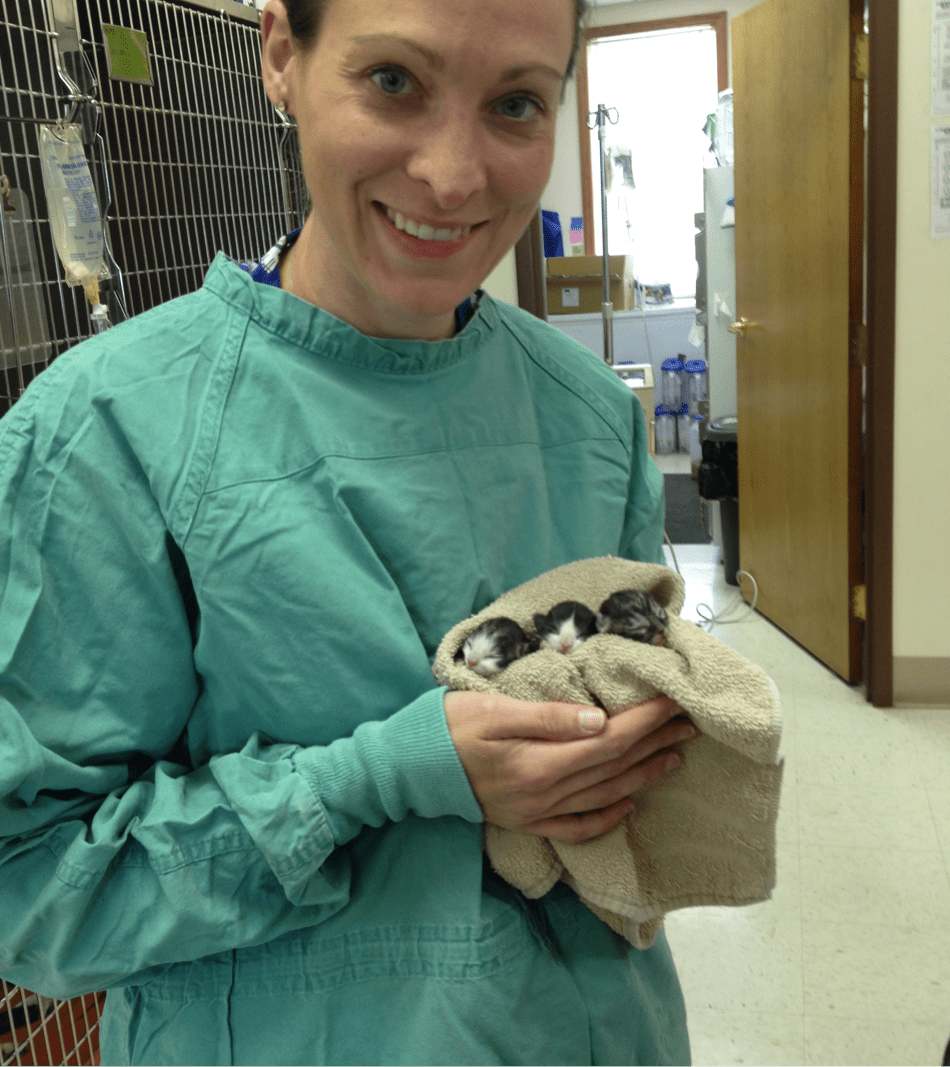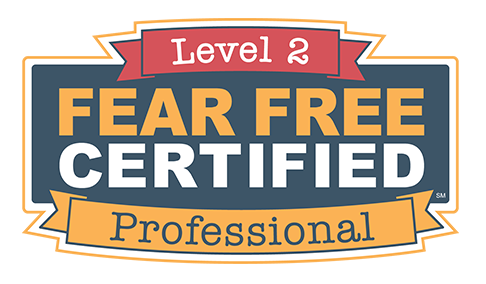[vc_row][vc_column][trx_section box=”yes”][trx_title align=”center” color=”#d9ae4c” weight=”700″]
From the Trenches
[/trx_title][trx_title align=”center” color=”#d9ae4c” weight=”700″]
A Vet’s Story
[/trx_title][trx_title type=”4″ align=”center” color=”#434544″ weight=”700″ bottom=”mini”]by Dr. Eileen Savier CVA, CVCH[/trx_title][vc_column_text]

Presenting Complaint: Medication Overdose
It was just your average day at the veterinary clinic and I was a relatively new doctor – having only practiced four years. I went from school straight into general practice, so experience managing toxicities as the primary doctor at that point had been limited to the protection of school. One of our receptionist’s dogs (~75lbs) was taking an anti-inflammatory for a surgery she had on her knee. Lemon, a kitty only weighing 9 lbs, ate the entire dose of medication (beef flavored to make the medicine easier to give pets). Time, as you can imagine, is very sensitive in this situation. This was enough of a drug overdose to to cause acute kidney failure leading to death or if she survived chronic kidney failure in a two year old cat. Typically in a case like this I would induce vomiting, check initial lab work, start supportive care and refer the kitty to OSU veterinary medical hospital as it is the only place in our state with a board certified veterinary criticalist. That was not possible due to financial limitations – as I suspected this would cost $2,500.00 to $3,500.00 to be in the ICU. After discussing Lemon’s case with the toxicologist, her prognosis was very guarded. So I straightened my stethoscope and got to work.
I tried to make Lemon vomit using two different medications, but was unsuccessful. So I took Lemon to surgery. Once she was asleep and her airway was protected, I performed a gastric lavage to try to remove any medication that was still left in her stomach. Once that was done, I put activated charcoal in her stomach to help prevent absorption of any medication that remained or was in the small intestine. Then we woke her up and hoped for the best. We started medication to help heal any stomach or intestinal ulcers that had formed and monitored her lab work very closely.
When she woke up she wasn’t eating, drinking, or producing urine. We gave a medicine to help promote urination and continued IV fluids. This medication worked well and Lemon started to produce urine. The next problem I encountered was that Lemon’s blood potassium levels were dangerously high – a direct result to the damage done to the kidney’s by the medication, but can cause heart problems if the levels are too high. To resolve the increased blood levels of potassium, I gave Lemon a dose of fast acting insulin – which is very dangerous because Lemon’s blood sugar levels are normal and she was producing her own insulin (unlike a diabetic animal that requires insulin to reduce blood sugar levels). The insulin will trigger a mechanism at the cellular level that will drive the extra potassium in the blood into cells and prevent problems with her heart. But it will also cause a rapid decrease in her blood sugar- crap! Now while correcting one problem, I was creating another.
I added dextrose to her IV fluids to maintain normal blood sugar. This brings us to approximately hour 19 after the initial ingestion of medication. I had also not been able to re-check her potassium levels because it was the middle of the night. I kept her in my kitchen when I set up a makeshift ICU and got a few hours of sleep, I wasn’t sure Lemon was going to be alive when I got up in a few hours….bu she was!
Not only was she alive, but her next set of lab work was surprisingly good showing only Stage 2 Renal Disease. She also started eating and was starting to look like a cat again. Lemon continued to do well and I took her off IV fluids at day three when I was sure her lab work was stable. At this time we put her on a canned prescription diet designed for chronic kidney failure and sent her home. Her renal values continued to improve over the following year and Lemon was transitioned back to regular cat food.
Lemon is a lucky kitty and enjoys snuggles with her family to this day. The moral of this story is that medications for people or for other pets need to be kept safe. Especially when medication for pets (and children) are flavored to make it easier to give. Keep those puppies, and kitties, safe friends.
[/vc_column_text][/trx_section][/vc_column][/vc_row][vc_row css=”.vc_custom_1533135180690{margin-top: 40px !important;}”][vc_column css=”.vc_custom_1533134942241{background-color: #d9ae4c !important;}”][trx_title type=”2″ align=”left” color=”#f6f2e4″ left=”20″ right=”20″]About Dr. Eileen Savier[/trx_title][vc_column_text css=”.vc_custom_1533135315368{padding-right: 20px !important;padding-bottom: 30px !important;padding-left: 20px !important;}”] Barks & Recreation is proud to feature Dr. Eileen Savier CVA, CVCH as our Veterinary Blogger in our “From the Vet” Series. Currently part of the team of doctors at Keystone Veterinary Clinic, Dr. Savier is a 2012 Graduate of the Ross University School of Veterinary Medicine, She completed her clinical experience at The Ohio State University and after veterinary school she pursued further education and certification in Veterinary Acupuncture, Chinese Herbal Medicine, and Fear Free veterinary visits. Dr. Savier has a special interest in integrative medicine, animal behavior, and internal medicine and is committed to improving animal health care by integrating Eastern and Western philosophies. She enjoys working with fearful & aggressive dogs and cats and she has had additional training in low stress handling techniques and encourages positive reinforcement during exams and procedures. Her clinical interests include pain management, animal behavior, geriatric patient care, and internal medicine. Dr. Savier is a member of the following associations:
Barks & Recreation is proud to feature Dr. Eileen Savier CVA, CVCH as our Veterinary Blogger in our “From the Vet” Series. Currently part of the team of doctors at Keystone Veterinary Clinic, Dr. Savier is a 2012 Graduate of the Ross University School of Veterinary Medicine, She completed her clinical experience at The Ohio State University and after veterinary school she pursued further education and certification in Veterinary Acupuncture, Chinese Herbal Medicine, and Fear Free veterinary visits. Dr. Savier has a special interest in integrative medicine, animal behavior, and internal medicine and is committed to improving animal health care by integrating Eastern and Western philosophies. She enjoys working with fearful & aggressive dogs and cats and she has had additional training in low stress handling techniques and encourages positive reinforcement during exams and procedures. Her clinical interests include pain management, animal behavior, geriatric patient care, and internal medicine. Dr. Savier is a member of the following associations:
- American Veterinary Medical Association (AVMA)
- International Veterinary Academy of Pain Management (IVAPM)
- American Association of Feline Practitioners (AAFP)
- American Veterinary Society of Animal Behavior (AVSAB)
- American Association of Traditional Chinese Veterinary Medicine (AATCVM)
- Ohio Veterinary Medical Association (OVMA)
Dr. Savier shares her home with two (soon to be three) dogs, two cats, and a toddler. She lovingly refers to her two dogs as Coconut Retrievers as they were rescue dogs she brought home from the island of St. Kitts. In her free time she enjoys spending time with her family, going to the beach, and planning her next Disney vacation.
Join us every month for Dr. Savier’s “From the Vet” series to get more information related to the health and welfare of your furry family members![/vc_column_text][/vc_column][/vc_row]

 Barks & Recreation is proud to feature Dr. Eileen Savier CVA, CVCH as our Veterinary Blogger in our “From the Vet” Series — offering information related to the health and welfare of your furry family members! Currently part of the team of doctors at Keystone Veterinary Clinic, Dr. Savier is a 2012 Graduate of the Ross University School of Veterinary Medicine, She completed her clinical experience at The Ohio State University and after veterinary school she pursued further education and certification in Veterinary Acupuncture, Chinese Herbal Medicine, and Fear Free veterinary visits. Dr. Savier has a special interest in integrative medicine, animal behavior, and internal medicine and is committed to improving animal health care by integrating Eastern and Western philosophies. She enjoys working with fearful & aggressive dogs and cats and she has had additional training in low stress handling techniques and encourages positive reinforcement during exams and procedures. Her clinical interests include pain management, animal behavior, geriatric patient care, and internal medicine.
Barks & Recreation is proud to feature Dr. Eileen Savier CVA, CVCH as our Veterinary Blogger in our “From the Vet” Series — offering information related to the health and welfare of your furry family members! Currently part of the team of doctors at Keystone Veterinary Clinic, Dr. Savier is a 2012 Graduate of the Ross University School of Veterinary Medicine, She completed her clinical experience at The Ohio State University and after veterinary school she pursued further education and certification in Veterinary Acupuncture, Chinese Herbal Medicine, and Fear Free veterinary visits. Dr. Savier has a special interest in integrative medicine, animal behavior, and internal medicine and is committed to improving animal health care by integrating Eastern and Western philosophies. She enjoys working with fearful & aggressive dogs and cats and she has had additional training in low stress handling techniques and encourages positive reinforcement during exams and procedures. Her clinical interests include pain management, animal behavior, geriatric patient care, and internal medicine. Dr. Savier shares her home with two (soon to be three) dogs, two cats, and a toddler. She lovingly refers to her two dogs as Coconut Retrievers as they were rescue dogs she brought home from the island of St. Kitts. In her free time she enjoys spending time with her family, going to the beach, and planning her next Disney vacation.
Dr. Savier shares her home with two (soon to be three) dogs, two cats, and a toddler. She lovingly refers to her two dogs as Coconut Retrievers as they were rescue dogs she brought home from the island of St. Kitts. In her free time she enjoys spending time with her family, going to the beach, and planning her next Disney vacation.




